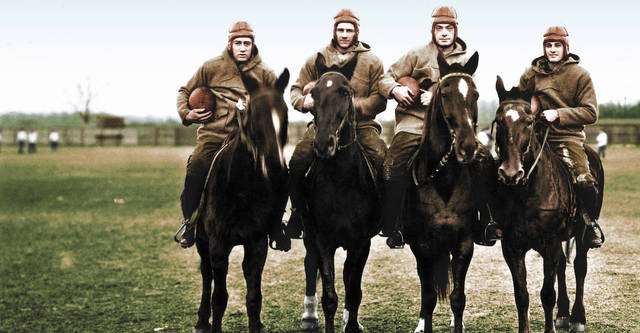Playtime Documents America's Quest for Leisure Activities
A history of fun


America in Color: Playtime. Smithsonian Channel. Sunday, December 9, 8 p.m.
As Christmas shoppers rampage through malls like George Romero zombies, it's hard to imagine that there was ever a time when amusing ourselves was not a big business. But for the country's first hundred years or so, Americans spent most of their spare time trying to avoid being eaten by bears or turning into giant smallpox sores. It was until the 20th century that the concept of leisure time—and the yearning for stuff to fill it—really caught on.
Playtime, an episode of the Smithsonian Channel's series America in Color, tells the story of that primitive quest for fun in (mostly) breezy style. With a remarkable collection of vintage film footage—much of it assembled from home movies—Playtime covers everything from the turn of the century amusement parks on Coney Island to the 1953 advent of the Rodent Empire headquartered at Disney World; from wing walkers to flagpole sitters, from the lost art of sand yachting to a federally funded, all-black production of Macbeth set in Haiti.
Whether that production (which became known as Voodoo Macbeth because director Orson Welles replaced Shakespeare's witches with voodoo priests) was a sensible use of taxpayer dollars at the height of the Depression or why it needed a government at all—the show was wildly popular and went on a 4,000-mile tour of the country after its Harlem debut—is precisely the sort of question not asked in Playtime, which is descriptive rather than analytical and prefers the lighthearted side of history to the dour.
Even so, it has its sad moments, particularly during a segment on the 1910 heavyweight boxing championship match between black champ Jack Johnson and the original Great White Hope, James Jeffries. The fight attracted so much attention that a new 22,000 stadium was built in Reno to hold it.
When the fight ended with Johnson literally knocking Jeffries out of the ring, whites rioted in cities all over the country and Congress banned the interstate transportation of boxing film footage in a futile (but long-lived; the law stood until 1940) attempt to keep anybody from seeing a black beating a white one. Nearly 50 years after the end of the Civil War, little had changed in American race relations except the legal paperwork.
Less ugly but more poignant is a chunk of Playtime devoted to Japanese-American semi-pro baseball in California during the 1920s. The Japanese saw the sport as "a way to American themselves and win the respect of their white neighbors," explains Playtime's narrator. And indeed, when major league stars led by Babe Ruth and Lou Gehrig came to California during an off-season exhibition tour, they asked a couple of the Nisei players to join their teams for a game.
But it's hard to watch film of the game without wondering how many of them, 15 years later, would be herded into internment camps for the duration of World War II, their Americanization negligible as far as the U.S. government was concerned.
But the sore spots in Playtime quickly give way to the amusing ones. As U.S. wages grew and work weeks shrank, recreation turned into the country's fastest growing industry, one not fazed even by the Depression. By 1939, Americans were spending $3.8 billion a year in pursuit of fun.
The madcap chase went in all directions. Playtime's footage includes scenes from a fanciful Girl Scout training film about campouts in which the girls pitch their tents, cook their dinners, and solve crimes. (It's not clear if that last one is for a merit badge or just a byproduct of intensive study of Dick Tracy's Crimestoppers Textbook.)
The scouts were rivaled only by Charles Atlas, one of the bodybuilders on Santa Monica, California's so-called Muscle Beach, who saved America's helpless throngs of 90-pound weaklings from a wave of terrorist sand-kicking with his home workout courses.
Then there's newsreel film of Knute Rockne overseeing Notre Dame football practices, interesting less for the passing routes than Rockne's pioneering genius for marketing. He not only welcomed cameras to his practices, but even re-staged some of his locker room pep talks for them. Rockne turned a sportswriter's flippant reference to one of his backfields as the Four Horseman of the Apocalypse into a national catchphrase by posing the boys on real horses, then mailing the photo to every daily newspaper in America.
Less immortal were the women of the All-American Girls Professional Baseball League, created by Chicago Cubs owner Phil Wrigley during World War II, when the military draft took a lot of the ooomph out of the major leagues. Far from a powderpuff publicity stunt, the women's league was arguably made of tougher stuff than the majors; Playtime includes newsreel shots of Rockland Peaches players, in their skirt uniforms, sliding bare-legged into the bases.
Yet when the league folded after the Musials and DiMaggios came home, it almost immediately disappeared into the mists of history. It took 40 years for the women to get their due, in the Tom Hanks movie A League of Their Own, which established a catchphrase that promises to be more enduring even then the Four Horsemen: "There's no crying in baseball!"



Show Comments (19)